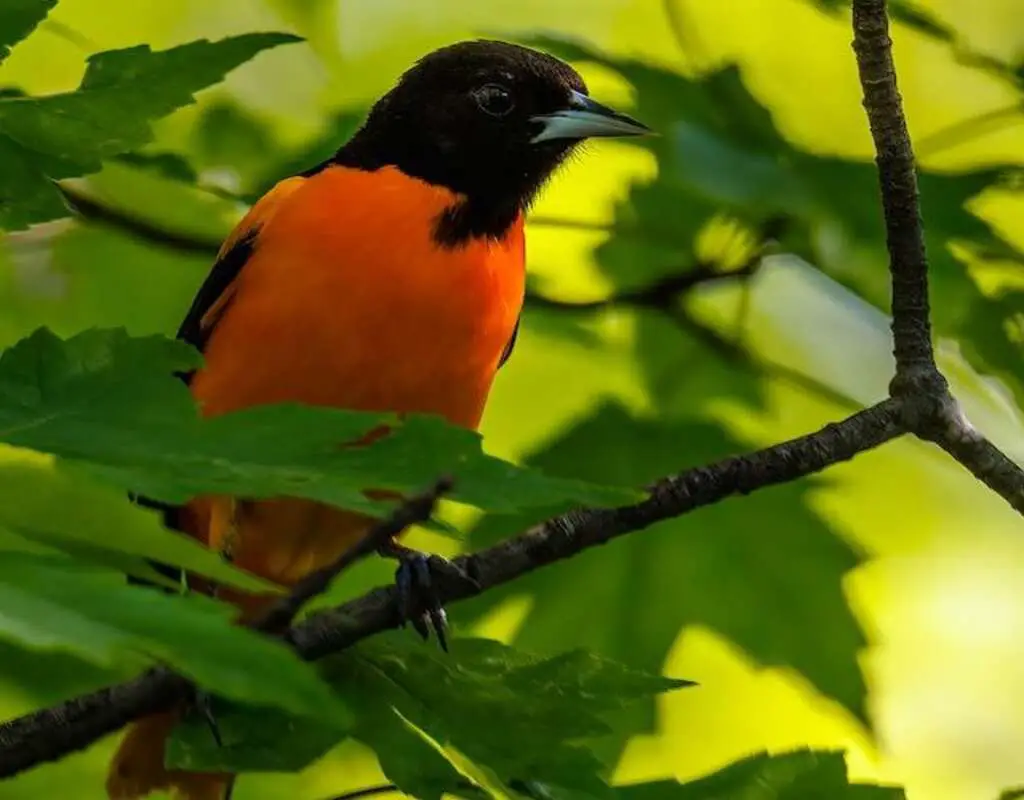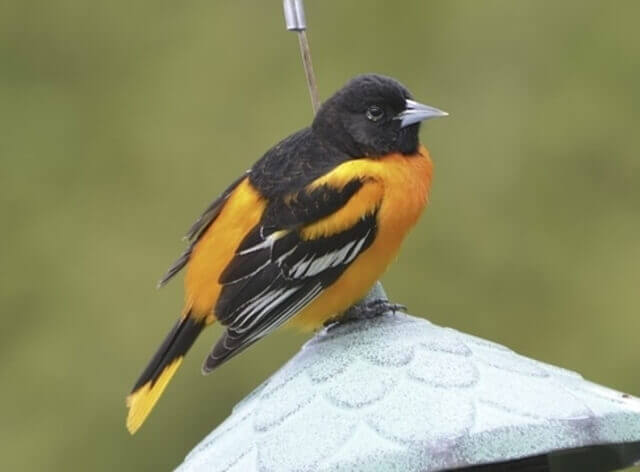Hungry for some bird culinary adventures? Learn the art of pleasing Baltimore Orioles’ discerning palates with homemade delights!
In this article, we’ll reveal the short answer to “How To Make Baltimore Oriole Food?” and dish out mouthwatering recipes that will have these vibrant birds flocking to your backyard.
Get ready to become a gourmet chef for your feathered friends!
Table of Contents
- 1 Understanding Baltimore Orioles’ Dietary Needs
- 2 How To Make Baltimore Oriole Food?
- 3 Basic Tools and Ingredients
- 4 Making Oriole Nectar
- 5 Creating Oriole Fruit Mixes
- 6 Offering Insects and Mealworms
- 7 Providing Water Sources
- 8 Feeding Orioles in Different Seasons
- 9 Tips for Attracting Orioles
- 10 Frequently Asked Questions
- 10.1 How do I attract Baltimore Orioles to my backyard in the first place?
- 10.2 Can I use regular sugar instead of white granulated sugar for making oriole nectar?
- 10.3 How often should I change the nectar in my oriole feeder?
- 10.4 Is it safe to offer mealworms to Baltimore Orioles?
- 10.5 What should I do if I see a sick or injured Baltimore Oriole in my yard?
- 11 Conclusion
- 12 Author
Understanding Baltimore Orioles’ Dietary Needs
The dietary requirements of the Baltimore Oriole are crucial to understand in order to provide appropriate nourishment for their optimal health and well-being.
As migratory birds, Baltimore Orioles have different dietary needs depending on the season and their location.
During migration, they require high-energy foods such as fruit and nectar to fuel their long journey.
Once they reach their preferred feeding habitats, they switch to a diet that includes insects, spiders, and other small invertebrates.
Understanding the specific dietary needs of Baltimore Orioles is essential for creating a suitable food source for them.
In the next section, we will discuss the basic tools and ingredients needed to make Baltimore Oriole food.

How To Make Baltimore Oriole Food?
In this section, we will guide you through the process of making Baltimore Oriole food. Learn simple and effective recipes that will attract these vibrant birds to your yard, ensuring they have a delicious and nutritious meal.
Basic Tools and Ingredients
This section outlines the necessary utensils and ingredients required to concoct a nourishing meal for a particular species of bird that is commonly found in the eastern region of North America.
To begin with, essential equipment includes a sturdy, well-anchored feeder that can hold a good amount of food, as well as a dish or tray to hold the food.
Proper sanitation is vital to keep the feeder clean and free from any bacteria or mold that can contaminate the food and harm the birds.
As for the ingredients, Baltimore Orioles primarily feed on insects, fruits, and nectar.
For their diet, you will need mealworms, grape jelly, oranges, and sugar. These ingredients can be found at a local pet store or grocery store.
With these basic tools and ingredients, you can create a delicious and nutritious meal that will attract Baltimore Orioles to your backyard.
The next section will discuss the step-by-step process of making oriole nectar.
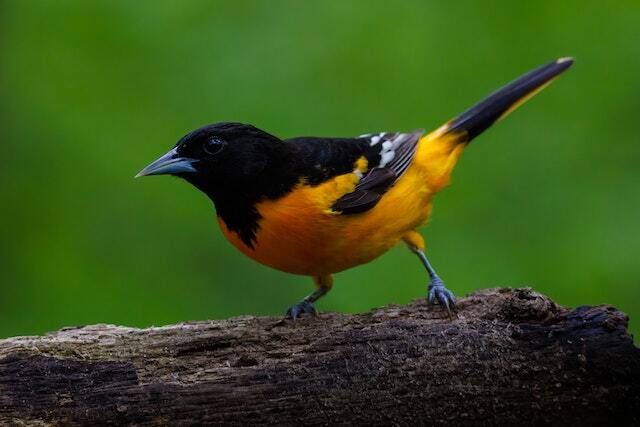
Making Oriole Nectar
This subtopic discusses the process of making oriole nectar, including the recipe for homemade nectar, tips for storing and serving the nectar, and alternatives to nectar.
Making nectar is a simple process that involves mixing sugar with water in a specific ratio.
It is important to store and serve the nectar properly to ensure that it remains fresh and safe for the birds.
Additionally, there are alternative foods that can be offered to orioles, such as fruit and jelly.
Recipe for Homemade Nectar
Crafting a homemade nectar is a simple and effective way to provide sustenance for these colorful birds.
The benefits of homemade nectar are numerous, as it ensures that the orioles are receiving a natural and nutritious food source without any additives or preservatives.
There are also variations of nectar recipes that can be catered to specific preferences or dietary needs.
For example, adding a small amount of honey or maple syrup can provide additional nutrients, while reducing the amount of sugar used can be beneficial for those who are watching their sugar intake.
When making homemade nectar, it is important to use a 4:1 ratio of water to sugar, as this reflects the sugar concentration found in the nectar of flowers.
Once the nectar is made, it is crucial to store it properly in a clean container and replace it every 2-3 days, as it can spoil quickly in warmer temperatures.
By following these simple tips for storing and serving, you can ensure that the orioles in your backyard are well-fed and happy.
| Steps | Ingredients and Instructions |
|---|---|
| Step 1 | Combine 1 part white granulated sugar |
| with 4 parts boiling water. | |
| Step 2 | Stir until the sugar dissolves. |
| Step 3 | Let the nectar cool to room temperature. |
| Step 4 | Fill your Oriole feeder with the prepared nectar. |
| Additional Tips | – Avoid using honey or artificial sweeteners as they can be harmful to birds. |
| – Replace the nectar every 2-3 days, especially in hot weather, to prevent spoilage and keep it fresh for the Orioles. |
Tips for Storing and Serving
Proper storage and regular replacement of homemade nectar is crucial in ensuring the provision of a natural and nutritious food source for orioles in a manner that minimizes the risk of spoilage.
To store the nectar, it is recommended to keep it in a clean and dry container, preferably made of glass or plastic. The container should be tightly sealed and stored in a cool place, away from direct sunlight.
It is also important to check the nectar regularly for any signs of spoilage, such as cloudiness or discoloration, and to replace it every 2-3 days.
When serving the nectar, make sure to use clean and sanitized feeders, and to place them in a location that is easily accessible to orioles, but also safe from predators.
Additionally, consider adding fresh fruit or jelly to the feeder as a supplement to the nectar.
By following these storing tips and serving suggestions, you can ensure that your orioles are provided with a healthy and delicious food source.
As an alternative to nectar, there are also a variety of other foods that orioles enjoy, such as mealworms, suet, and fresh fruit.
Alternatives to Nectar
A variety of delectable options exist as substitutes for nectar, such as mealworms, suet, and fresh fruit, which can satiate the appetite of the charming oriole.
Orioles are known for their love of sweet nectar, but they also require protein sources in their diet.
Fresh fruit is an excellent alternative to nectar, as it provides natural sugars and essential vitamins and minerals, while also satisfying the oriole’s sweet tooth.
Some popular fruit alternatives include oranges, grapefruits, and bananas. These fruits can be sliced into small pieces and placed in a feeder or on a tray for the orioles to enjoy.
Additionally, protein sources like mealworms and suet can be offered to the orioles. Mealworms are a great source of protein, and orioles are known to enjoy them.
Suet is also an excellent protein source, but it should be offered in small amounts during the summer months, as it can melt in high temperatures.
Creating oriole fruit mixes is a fun and innovative way to provide a variety of options for these beautiful birds.
By incorporating different fruits and protein sources into a mix, you can ensure that your feathered friends are getting all the necessary nutrients in their diet.
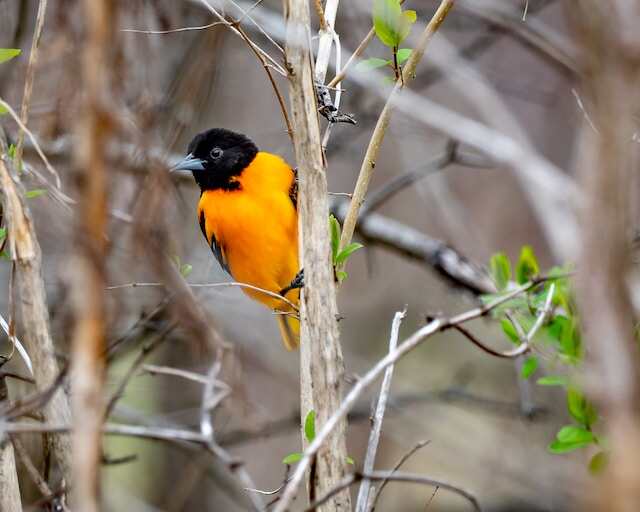
Creating Oriole Fruit Mixes
The creation of a fruit mix for orioles is a crucial step in providing a nutritious and appealing diet for these birds.
Mixing fruits such as oranges, apples, grapes, and berries can provide a variety of flavors that orioles will enjoy.
It is important to choose fruits that are high in natural sugars and nutrients to provide the energy that these birds need.
Additionally, incorporating different textures, such as chopped or pureed fruits, can add variety to the mix.
When creating a fruit mix, it is essential to ensure that the fruits are fresh and have not been treated with pesticides or other harmful chemicals.
By offering a diverse range of fruits, orioles will have access to the necessary nutrients to maintain their health and energy levels.
Transitioning into offering insects and mealworms can further supplement their diet and provide the necessary protein for growth and development.

Offering Insects and Mealworms
Insects and mealworms are a crucial part of the Baltimore Oriole’s diet. They provide the necessary protein and nutrients that are essential for the bird’s survival and breeding success.
When offering insects and mealworms, it is important to choose the right ones and properly prepare and serve them to ensure the birds receive maximum nutritional benefits.
Benefits of Insects and Mealworms
The incorporation of insects and mealworms in the diet of Baltimore Orioles may provide vital benefits in terms of nutrition. These foods are rich in protein, which is essential for the survival and health of these birds.
Insects and mealworms are also a natural source of vitamins and minerals that are not present in other types of bird food.
For example, crickets are a great source of calcium, while waxworms contain high levels of fat that are necessary for energy.
Offering insects and mealworms can also stimulate the natural foraging behavior of Baltimore Orioles, which promotes physical and mental health.
Providing a varied diet that includes different types of insects is important to ensure that the birds receive a balanced range of nutrients.
By choosing the right insects, bird enthusiasts can provide a nutritious and engaging diet that supports the well-being of these beautiful birds.
Choosing the Right Insects
Selecting appropriate insect types is crucial in providing a diverse diet that offers a balanced range of nutrients for optimal health and well-being of birds.
Identifying preferred insects is essential in providing the necessary nutrition for Baltimore Orioles.
Mealworms, crickets, waxworms, and grasshoppers are some of the most commonly preferred insects by these birds.
However, common mistakes made in insect selection include choosing insects that have been exposed to pesticides or are too large for the bird to swallow.
It is also crucial to ensure that the insects are alive and not frozen, as the bird’s natural instincts are to hunt for live prey.
Offering a variety of insects will provide the necessary nutrients and prevent boredom in the bird’s diet. Providing a diverse diet of insects and mealworms will keep Baltimore Orioles healthy and happy.
Next, we will discuss preparing and serving insects and mealworms.
Preparing and Serving Insects and Mealworms
Proper preparation and serving methods for insects and mealworms are essential in ensuring that Baltimore Orioles receive a well-balanced diet that meets their nutritional needs.
When preparing live prey, it is important to ensure that they are clean and free of any harmful pesticides or chemicals.
Additionally, it is recommended to use feeders for mealworms to avoid any accidental ingestion of substrate material.
Insectivorous diet variations can also be considered, such as offering a mix of insects and fruits or nectar.
By providing a varied diet, Baltimore Orioles can receive the necessary nutrients for optimal health and growth.
As we move on to the next section about providing water sources, it is important to note that water should always be available for the birds to drink and bathe in to maintain good hygiene.
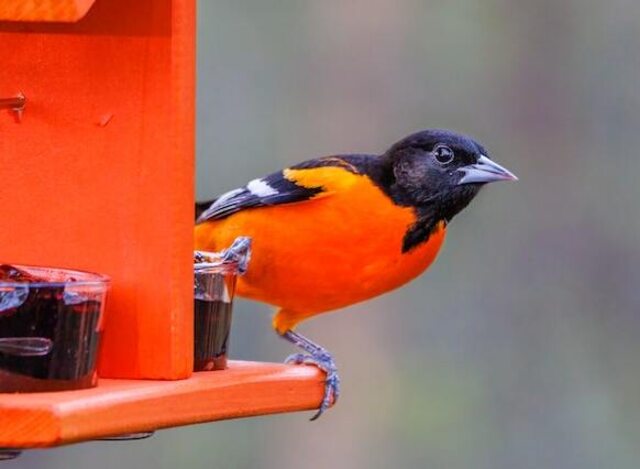
Providing Water Sources
Water sources are a crucial component in attracting Baltimore Orioles, as they not only need water for drinking but also for bathing, with an estimated 40% of their daily water intake coming from bathing.
It is important to ensure that the water sources are clean and fresh, as orioles are sensitive to impurities and may avoid dirty or stagnant water.
Providing a shallow bird bath or a dripping fountain can be an effective method for attracting orioles to your yard.
It is recommended to change the water frequently and clean the container regularly to maintain cleanliness.
Additionally, offering a variety of water sources, such as a mister or a shallow dish, can add to the appeal for orioles.
A table below shows the types of water sources and their benefits for attracting Baltimore Orioles.
Moving on to the next section, feeding orioles in different seasons requires a different approach to ensure their dietary needs are met.
| Water Source | Benefits for Orioles |
|---|---|
| Shallow bird bath | Allows for bathing and drinking |
| Dripping fountain | Mimics natural water sources and attracts insects |
| Mister | Provides a mist for drinking and bathing |
| Shallow dish | Additional source of water and easy to clean |
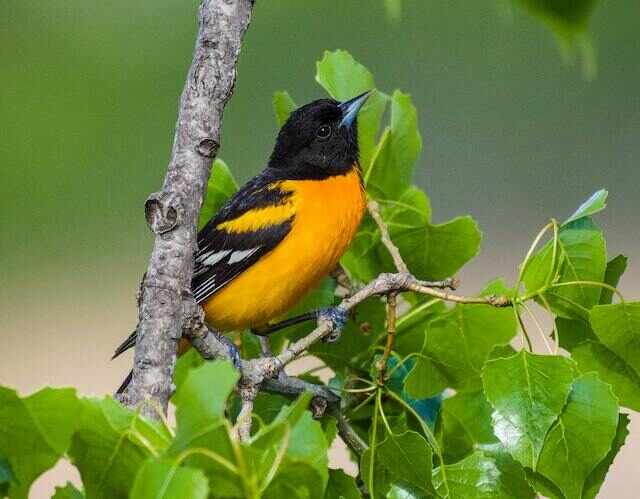
Feeding Orioles in Different Seasons
Feeding orioles may require different strategies for different seasons.
During spring, orioles are returning from their migration and are in need of high-energy foods to help them regain strength.
In summer, orioles may prefer more protein-rich foods as they begin their nesting season.
And in fall and winter, orioles will require an abundance of fatty and sugary foods to help them prepare for migration or survive the cold months.
Understanding these dietary needs is crucial in providing proper nutrition for these beautiful birds.
Spring Feeding
During the spring season, providing a nutritionally balanced and diverse diet for birds can aid in their overall health and survival.
Baltimore Orioles are no exception, and it is important to consider the best feeders and ways to attract flowers to provide a variety of nectar, fruit, and insects.
Oriole feeders with perch areas and bright orange color can be used to attract these brightly colored birds, while planting native flowers such as trumpet vine, bee balm, and cardinal flower can provide a natural food source.
Additionally, offering mealworms and jelly can supplement their diet and increase the chances of attracting them to your yard.
Providing a diverse diet during the spring can also prepare them for nesting and breeding, ensuring a healthy and successful season.
Moving into the summer, it is important to continue providing a varied diet to support their growing families.
Summer Feeding
Summer is a critical time to ensure that birds receive a diverse and balanced diet, as it can support the growth and development of their families.
When feeding Baltimore Orioles, it is important to follow a feeding schedule to ensure they receive the proper nutrients they need during the summer months.
Oriole feeders should be filled with fresh nectar every 2–3 days and fresh fruit, such as oranges and grapes, should also be provided.
These fruits can be placed on a spike or tray feeder to attract the orioles. In addition, jelly and mealworms can also be offered to provide a variety of food options.
It is important to avoid using insecticides or pesticides in the area, as these can harm the orioles and their young.
By using these attracting methods, orioles will visit your feeders and provide entertainment during the summer months.
As fall and winter approach, it is important to transition to feeding the orioles with suet and other high-fat foods to help them prepare for migration and survive the colder months.
Fall and Winter Feeding
As the seasons change and temperatures drop, providing a diverse and high-fat diet can aid in the survival and preparation for migration of various bird species, including Baltimore orioles.
During the fall and winter months, it is important to provide the best foods for orioles, such as suet, peanuts, and mealworms, to ensure that they have enough energy to withstand the colder weather.
A feeding schedule that includes multiple feedings per day can also help prevent waste and attract more birds to the feeding area.
However, it is important to be mindful of the amount of food being put out, as excess food can attract unwanted predators.
By providing a diverse and high-quality diet, bird enthusiasts can help ensure that Baltimore orioles are well-fed and prepared for their upcoming migration.
With that said, there are also tips for attracting orioles that can be implemented.
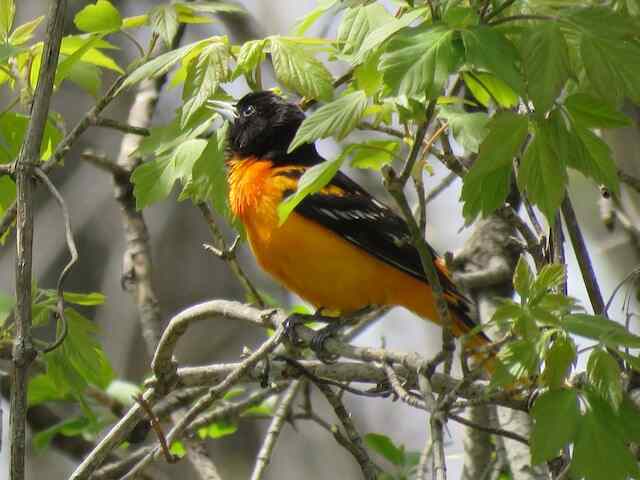
Tips for Attracting Orioles
Attracting orioles to your backyard requires careful planning and attention to detail. Choosing the right location is crucial, as orioles prefer open spaces with plenty of sunlight and nearby sources of water.
Creating a safe environment is also important, as orioles are vulnerable to predators and may be deterred by noisy or busy areas.
Finally, maintaining your feeding station with fresh food and regular cleaning will ensure that your feathered friends keep coming back for more.
Choosing the Right Location
Selecting an appropriate location is crucial for creating an environment that attracts the Baltimore Oriole. Studies have shown that the bird prefers to nest in tall deciduous trees that are at least 20 feet high.
In addition to choosing the right location, setting up the feeding station in the right spot is equally important. Here are three tips for selecting the perfect spot for your Baltimore Oriole feeder:
1) Place the feeder in a sunny area, as the bird prefers to feed in well-lit areas.
2) Make sure the feeder is at a height of 4–5 feet off the ground to prevent predators from accessing it.
3) Position the feeder away from areas with high traffic, such as walkways or playgrounds to avoid disturbance.
By following these tips, you can create an ideal environment for the Baltimore Oriole to feed and nest. Creating a safe environment is the next step in attracting this beautiful bird to your garden.
Creating a Safe Environment
Establishing a secure environment for the Baltimore Oriole requires implementing measures to prevent potential threats such as predators, harsh weather, and unsanitary conditions.
One way to create a safe environment is by creating birdhouses and selecting perches that are sturdy enough to withstand strong winds.
Another helpful technique is to use decoys and predator control to keep unwanted animals away from the feeding station.
It is also important to regularly clean and disinfect the feeding area to prevent the spread of disease.
By taking these precautions, you can ensure that your Baltimore Oriole food station is a safe haven for these beautiful birds.
In the next section, we will discuss how to maintain your feeding station to keep it in top condition for the Orioles.
Maintaining Your Feeding Station
Creating a safe environment for Baltimore Orioles to feed is just the first step in attracting these beautiful birds to your backyard.
Once your feeding station is set up, it is crucial to maintain it properly to ensure that the birds are getting the best possible food and that the feeding station remains a safe and healthy place for them to visit.
To do this, it is important to establish a cleaning schedule to prevent the buildup of mold and bacteria that can be harmful to birds. Here are four essential tips for maintaining your feeding station:
1) Clean your feeding station regularly, at least once a week, with soap and hot water.
2) Replace the food and water at least every other day to prevent spoilage.
3) Use a bleach solution to disinfect your feeding station periodically, especially during warm and humid weather.
4) Remove any leftover food or debris from the feeding station to prevent the growth of mold and bacteria.
By following these simple steps, you can create a safe and healthy environment for Baltimore orioles to feed, while also preventing the spread of disease and ensuring that the birds receive the proper nutrition they need to thrive.
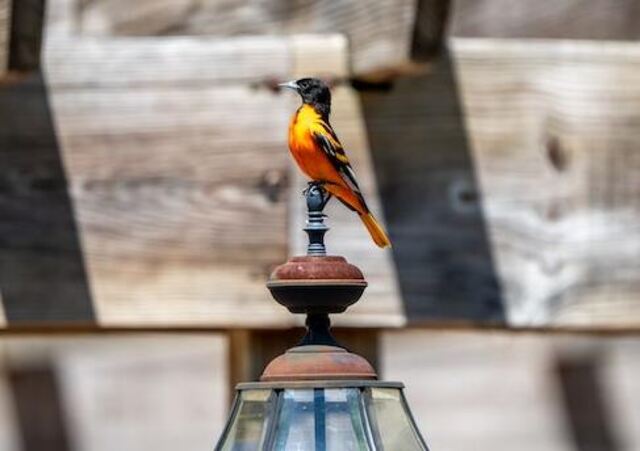
Frequently Asked Questions
How do I attract Baltimore Orioles to my backyard in the first place?
Attracting Orioles to one’s backyard can be a rewarding experience for bird enthusiasts. A crucial factor for attracting these birds is birdhouse placement. Orioles prefer open spaces with plenty of sunlight and a clear view of the surrounding area.
The birdhouse should be placed in an area that is at least six feet above ground and away from trees or shrubs that predators can use to climb or jump from.
Additionally, providing a water source, such as a birdbath, can also attract Orioles. Offering food, such as oranges or grape jelly, can supplement their natural diet and increase the likelihood of their return.
By following these tips, one can increase the chances of attracting Orioles to their backyard and enjoy their beautiful songs and vibrant colors.
Can I use regular sugar instead of white granulated sugar for making oriole nectar?
When it comes to attracting Baltimore Orioles to your backyard, one popular method is to prepare homemade oriole food. However, some individuals may question the use of white granulated sugar as the primary sweetener for the nectar.
In such cases, alternative sweeteners can be used to create a more diverse and nutritious meal for the birds.
These alternatives can include honey, agave nectar, or brown sugar, all of which provide a different flavor and nutritional profile than white granulated sugar.
It is important to note that regardless of the sweetener used, the nectar must be prepared with a 4:1 ratio of water to sweetener.
By using alternative sweeteners, bird enthusiasts can provide a more creative and impactful feeding experience for the Baltimore Orioles in their backyard.
How often should I change the nectar in my oriole feeder?
Maintaining the proper frequency of nectar changes and feeder cleaning is essential for the health and well-being of Baltimore Orioles.
Nectar frequency refers to the amount of time that passes before the nectar in the feeder needs to be changed.
It is recommended to change the nectar every two to three days, especially during the hot summer months, when it can spoil more quickly.
However, if the nectar appears cloudy or has an unpleasant odor, it should be changed immediately.
Feeder cleaning is also important to prevent the growth of harmful bacteria and mold. The feeder should be cleaned thoroughly with hot water and soap every time the nectar is changed.
Additionally, it is recommended to soak the feeder in a solution of one part white vinegar to four parts water once a month to disinfect it.
By adhering to these guidelines, bird enthusiasts can ensure that their feathered friends receive the best care possible.
Is it safe to offer mealworms to Baltimore Orioles?
The controversy surrounding the use of mealworms as a protein source for Baltimore orioles has been a topic of discussion among bird enthusiasts.
While mealworms are a great source of protein, some experts argue that they are not a natural food source for these birds and can cause health issues.
As such, some bird lovers have explored alternative protein sources such as offering fresh fruits, grape jelly, and nectar. These alternatives not only offer the necessary nutrients but also mimic the birds’ natural diet.
However, it is important to note that the debate on whether mealworms are safe for Baltimore orioles is ongoing, and bird lovers should consult with experts before making any dietary changes to their feathered friends.
What should I do if I see a sick or injured Baltimore Oriole in my yard?
If you happen to come across a sick or injured Baltimore Oriole in your yard, there are a few steps you can take to help.
The first step is to identify any symptoms of illness or injury that the bird may be exhibiting.
Once you have identified the issue, it is important to contact a wildlife rehabilitator who can provide the bird with proper care and treatment.
While waiting for the rehabilitator to arrive, you can create a safe space for the injured bird by placing it in a quiet and protected area.
It is important to remember that handling wild birds can be dangerous and should only be done by trained professionals.
By taking these steps, you can help ensure the safety and well-being of the Baltimore Oriole and help it on its road to recovery.
Conclusion
Understanding the dietary needs of Baltimore Orioles is crucial for attracting and keeping these beautiful birds in your backyard.
By providing a variety of foods, including nectar, fruit mixes, insects, and mealworms, you can create a welcoming environment for these feathered friends.
Additionally, offering water sources is essential for their survival and well-being.
To make oriole nectar, you will need sugar, water, and food coloring, which can be mixed together and placed in a feeder.
Oriole fruit mixes can be made by combining fresh or dried fruits, such as oranges, berries, and grapes. Insects and mealworms can be purchased at pet stores or collected from your garden.
Feeding Baltimore Orioles varies depending on the season. During migration, they prefer high-energy foods, such as nectar and fruit mixes.
In the summer, they rely more on insects and protein-rich foods. To attract these birds, it is essential to offer a variety of foods throughout the year.
In conclusion, attracting Baltimore Orioles to your backyard requires understanding their dietary needs and providing a welcoming environment.
By offering a variety of foods and water sources, you can create an oasis for these beautiful birds. As the famous metaphor goes, ‘if you build it, they will come.’
So, create a bird-friendly habitat and watch as these majestic creatures flock to your backyard.

